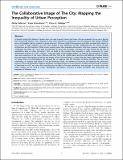The Collaborative Image of The City: Mapping the Inequality of Urban Perception
Author(s)
Schechtner, Katja; Salesses, Mark Philip; Hidalgo Ramaciotti, Cesar A.
DownloadPhilip Salesses-2013-The Collaborative Im.pdf (2.069Mb)
PUBLISHER_CC
Publisher with Creative Commons License
Creative Commons Attribution
Terms of use
Metadata
Show full item recordAbstract
A traveler visiting Rio, Manila or Caracas does not need a report to learn that these cities are unequal; she can see it directly from the taxicab window. This is because in most cities inequality is conspicuous, but also, because cities express different forms of inequality that are evident to casual observers. Cities are highly heterogeneous and often unequal with respect to the income of their residents, but also with respect to the cleanliness of their neighborhoods, the beauty of their architecture, and the liveliness of their streets, among many other evaluative dimensions. Until now, however, our ability to understand the effect of a city's built environment on social and economic outcomes has been limited by the lack of quantitative data on urban perception. Here, we build on the intuition that inequality is partly conspicuous to create quantitative measure of a city's contrasts. Using thousands of geo-tagged images, we measure the perception of safety, class and uniqueness; in the cities of Boston and New York in the United States, and Linz and Salzburg in Austria, finding that the range of perceptions elicited by the images of New York and Boston is larger than the range of perceptions elicited by images from Linz and Salzburg. We interpret this as evidence that the cityscapes of Boston and New York are more contrasting, or unequal, than those of Linz and Salzburg. Finally, we validate our measures by exploring the connection between them and homicides, finding a significant correlation between the perceptions of safety and class and the number of homicides in a NYC zip code, after controlling for the effects of income, population, area and age. Our results show that online images can be used to create reproducible quantitative measures of urban perception and characterize the inequality of different cities.
Date issued
2013-07Department
Massachusetts Institute of Technology. Engineering Systems Division; Massachusetts Institute of Technology. Media Laboratory; Program in Media Arts and Sciences (Massachusetts Institute of Technology)Journal
PLoS ONE
Publisher
Public Library of Science
Citation
Salesses, Philip, Katja Schechtner, and Cesar A. Hidalgo. “The Collaborative Image of The City: Mapping the Inequality of Urban Perception.” Edited by Alain Barrat. PLoS ONE 8, no. 7 (July 24, 2013): e68400.
Version: Final published version
ISSN
1932-6203